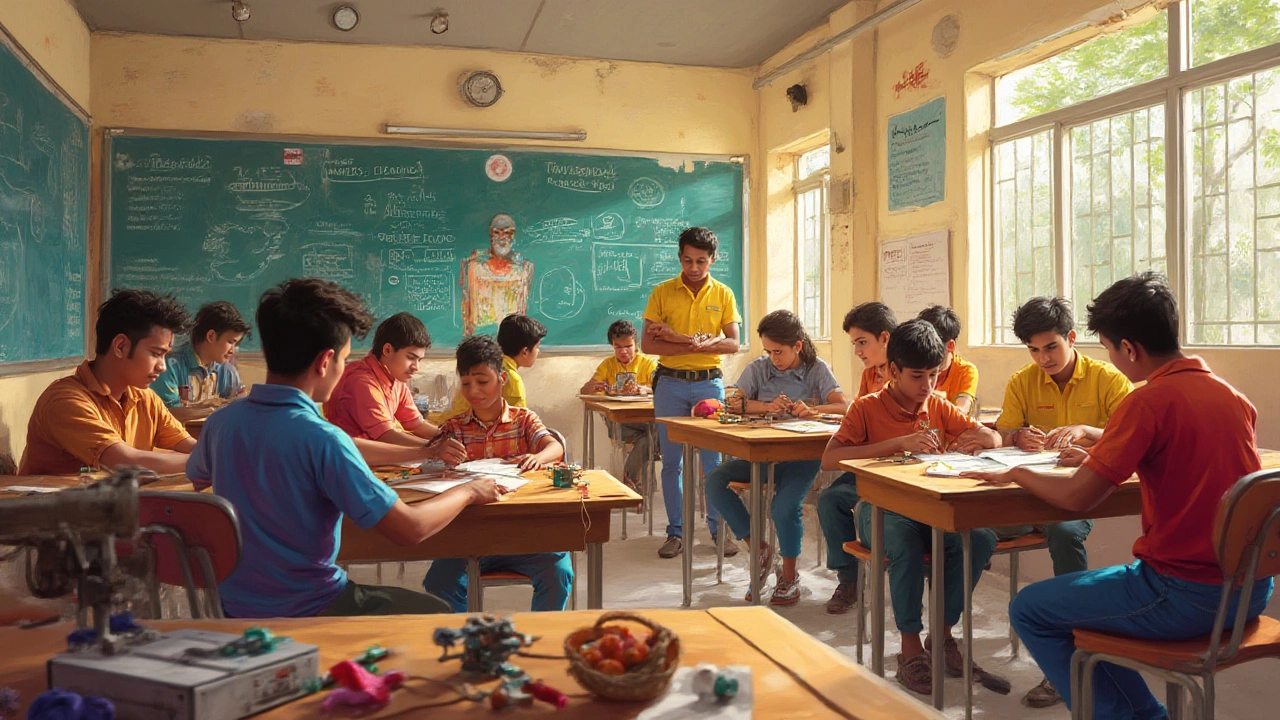Think about all the jobs out there that actually keep the world running—plumbers fixing leaks, bakers firing up loaves at sunrise, mechanics getting a car’s engine to purr, or nurses comforting patients in busy hospitals. It’s not only about studying endless theories in classrooms. Much of what we rely on comes straight out of the hands-on skills learned through vocational training—and that looks really different from the academic road most people picture when they hear “education.”
Breaking Down Vocational Training: What Does It Really Mean?
Vocational training focuses on practical skills for specific jobs, like learning to weld, cut hair, cook, repair air conditioners, or even draw blood. Instead of spending years in lectures about theory, students jump right in and start doing. It’s learning by working—the kind of education where you go home after class and can literally show what you’ve accomplished with your own two hands.
The main difference between vocational and traditional academic education is the goal. Training programs are built around real job roles. They’re typically short (often less than two years), intense, and totally focused on making sure someone’s ready for work as soon as possible. If you’re someone who likes to “learn by doing,” this path often makes more sense.
Lots of people think of vocational education as just “trade school,” but there’s more to it. The best programs partner directly with employers, set up workplace internships, or even run classes right inside factories, shops, or salons. Some of the hottest new fields—like solar panel installation and medical lab tech—are growing right inside vocational schools. And despite what some folks believe, the pay for skilled trades can often beat college-degree jobs. For example, in 2024, the median salary for electricians hit $61,590 in the US, and experienced plumbers and welders can earn much more, often straight out of training.
Types of Vocational Training Programs
Vocational training covers practically everything that involves hands-on or technical skill. Let’s break down a few of the big categories to get a feel for just how broad it is:
- Trade and Technical Training: Carpentry, plumbing, welding, auto repair, HVAC, masonry, and electrical work. These classes are typically packed with hands-on projects, apprenticeships, and sometimes involve paid work while learning.
- Healthcare Programs: Nursing assistants, dental hygienists, paramedics, phlebotomists, pharmacy technicians, and medical assistants. These programs blend time in the classroom with supervised stints in clinics or hospitals, and many lead to direct certifications.
- Information Technology (IT): Computer repair, network setup, cybersecurity, IT support specialist, coding bootcamps, and web design. The world now depends on tech skills you can pick up in a year or less.
- Cosmetology and Personal Care: Hairstylists, barbers, estheticians, nail technicians, and massage therapists all train in real-world salons, not just classrooms.
- Culinary Arts: Chefs, bakers, pastry designers, and caterers often get their start in kitchens—learning everything from food safety to menu planning and presentation.
- Business and Office Administration: Legal assistants, medical billing specialists, and office managers all learn software and paperwork skills that companies rely on daily.
- Manufacturing and Machinery: Machine operators, CNC programmers, quality control inspectors—these jobs require knowing how to run complex equipment, and you’ll get your hands on real machines, not just textbooks.
Most programs are available through community colleges, dedicated trade schools, technical high schools, and even some online platforms. Apprenticeships are especially common in the skilled trades, letting students earn while they learn. Programs usually end in a certification, diploma, or sometimes an associate degree—proof you actually know how to do the job.
Why People Choose Vocational Training: Real-World Benefits
The numbers tell the story: about 12 million students are enrolled in over 7,000 US vocational schools each year. Why? Here are the biggest draws:
- Fast Track to Good Jobs: Most vocational programs take 6 months to 2 years—university degrees can take up to 4. This means people hit the workforce quicker and with less debt.
- Job Security: Trades and technical roles are often “recession-proof”—cars will always need fixing, homes will always need electricians, and healthcare's always growing. In fact, the US Bureau of Labor Statistics projects that the demand for HVAC technicians will grow by 6% by 2033.
- Affordable Education: A full electrician or medical assistant course at a vocational college might cost $4,000 to $15,000 (that’s total, not per year). Compare that to a typical university, where each year can cost $20,000 or more.
- Hands-On Experience: You actually get to do the job, not just read about it. For many, that makes learning easier and more fun.
- Employer Connections: Many programs have direct links to companies looking for new hires. Internships and apprenticeships often lead straight to a full-time job offer.
Curious which trade jobs pay best? Check out this quick table with median US annual salaries for 2024:
| Job Title | Typical Training Length | Median Salary |
|---|---|---|
| Electrician | 4 years (apprenticeship) | $61,590 |
| Plumber | 4 years (apprenticeship) | $60,090 |
| Dental Hygienist | 2 years (associate degree) | $77,090 |
| HVAC Technician | 6 months-2 years (certificate) | $51,390 |
| Medical Assistant | 1 year | $38,270 |
One more cool fact: Many large companies, like Toyota and Siemens, run their own in-house vocational academies. They train and hire straight from class.

Spotting a Vocational Course: What Makes Training “Vocational”?
Sometimes courses get labeled as “vocational” when they’re really something else. So how do you spot the real thing?
- Specific Job Focus: The course names a career or job type (“plumbing certificate” or “auto repair technician”), not a vague area like “arts and sciences.”
- Practical Skills. You spend time doing. You'll work on engines, style real clients’ hair, wire boards, or use hospital equipment—not just study theory.
- Short Duration: Training lasts months, not years. Most full programs finish in two years or less, while some take just a few weeks.
- Certification or Diploma: Graduates get a job-ready credential—something employers actually want to see.
- Industry Connection: Many vocational schools have advisory boards from actual businesses to keep training up-to-date. You’ll usually see required internships, apprenticeships, or clinics with outside companies.
Here are a few real-world examples of classic vocational training courses:
- Nail technician program with hands-on salon hours.
- Certified nursing assistant (CNA) class, including supervised hospital experience.
- Auto body repair at a trade school, with real cars in the garage.
- Welding certification, where you practice arc welding under a pro’s eye.
- Commercial driving school training, ending with a road test and commercial license.
Pro tip for anyone reading: Before signing up, check if your training program has proper approval or accreditation. Many industries only recognize certificates from certain trusted organizations—so do your homework.
What Makes Vocational Training Different from College?
There’s sometimes confusion about what sets vocational education apart from college or university. Here’s what makes it stand out:
- Narrow vs. Broad: Vocational training focuses tightly on one career path, while a university degree usually covers a wider academic base.
- No “General Education”: You won’t find literature or algebra requirements in a plumbing course. Every class is tied right to the work you’ll do after graduation.
- Immediate Application: You’ll practice real-life tasks on real equipment. No months of theory before doing actual work.
- Short, Affordable Courses: Vocational programs take less time and money to complete, so students enter the workforce quickly, and tuition debt is usually way lower.
- Certifications, Not Degrees: Most programs give a diploma, trade license, or a technical certificate. These are what hiring managers want to see for specific skills, not just a general bachelor’s.
That’s why lots of adults switch to vocational training after earning a college degree they never use in the workplace—they realize specific skills are worth more than just a diploma collecting dust.
Here’s a cool stat to chew on: Research from Georgetown University found that 30% of Americans with an associate degree (many gained in vocational fields) actually make more money than bachelor’s degree holders. So if anyone ever calls vocational training “less than” college, just flash the numbers.
Tips for Choosing a Vocational Training Program
Picking the right course can seriously set you up for life, so here’s how to zero in on one that works for you:
- Research Careers: Start by thinking about what you’ll actually enjoy doing for hours every day. Talk to people already working in those jobs—it’s way more helpful than just reading online lists.
- Look for Accredited Programs: Not every certificate carries the same weight. Look for schools or programs recognized by the state or the industry’s main certifying bodies.
- Check Job Outcomes: The best schools proudly share job placement rates. If most grads find work within six months, you’re in good hands.
- Ask about Work Experience: The magic of vocational school is practice under real-world conditions. Make sure internships or apprenticeships are part of the deal.
- Compare Costs: Get the full picture—some programs look cheap upfront but charge for exams or supplies. Factor it all in.
- Think Local: A school with ties to local employers makes it way easier to get jobs nearby.
- Visit the Campus: The vibe matters! Tour the workshops, kitchens, simulators, or labs where you’ll actually train.
One more smart tip: If cash is tight, check if your state offers tuition grants for high-demand skills. Some states pay most or all the cost for public vocational education if you study in a field with a worker shortage—healthcare and skilled trades are top picks.
There’s no single right answer for everyone, but career-focused training works wonders for loads of people. If you’re itching to get started, want a job that’s always needed, or love the idea of building things you can touch, vocational training just might be the answer you’re looking for.





